8.4 /10 1 Votes
Initial release date 1982 | 4.2/5 My Abandonware | |||||||||||||||||||||||||||||||||
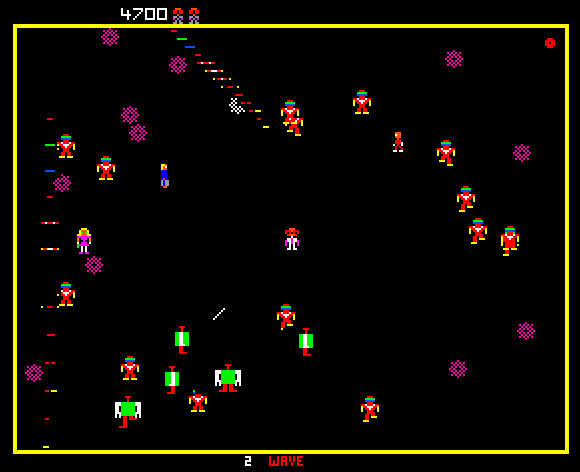 | ||||||||||||||||||||||||||||||||||
Genre(s) Multi-directional shooter Mode(s) 1-2 players, alternating turns Cabinet Upright, cabaret, and cocktail Display Horizontal orientation, Raster, standard resolution, size: 19 inch Publishers WMS Industries, Atari, Williams Entertainment Inc., Midway Games, Atari Corporation, Atarisoft, Shadowsoft Similar WMS Industries games, Shoot 'em up games | ||||||||||||||||||||||||||||||||||
John gets a robotron 2084 arcade game
Robotron: 2084 (also referred to as Robotron) is an arcade video game developed by Eugene Jarvis and Larry DeMar of Vid Kidz and released by Williams Electronics (part of WMS Industries) in 1982. It is a shoot 'em up with two-dimensional graphics. The game is set in the year 2084 in a fictional world where robots have turned against humans in a cybernetic revolt. The aim is to defeat endless waves of robots, rescue surviving humans, and earn as many points as possible.
Contents
- John gets a robotron 2084 arcade game
- Robotron 2084 arcade 1982 feat james rolfe video game years history
- Gameplay
- Development
- Enemy designs
- Reception
- Legacy
- Remakes and sequels
- Reverse engineering work
- Robotron II
- In other media
- References
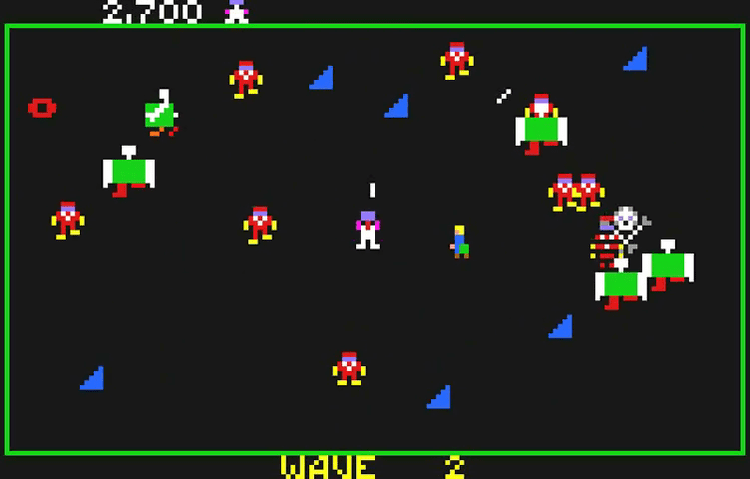
Robotron popularized the twin joystick control scheme, one that had previously been used in Taito's Space Dungeon.
Robotron: 2084 was critically and commercially successful. Praise among critics focused on the game's intense action and control scheme. The game is frequently listed as one of Jarvis's best contributions to the video game industry. Robotron: 2084 arcade cabinets have since become a sought-after collector's item. It was ported to numerous platforms.
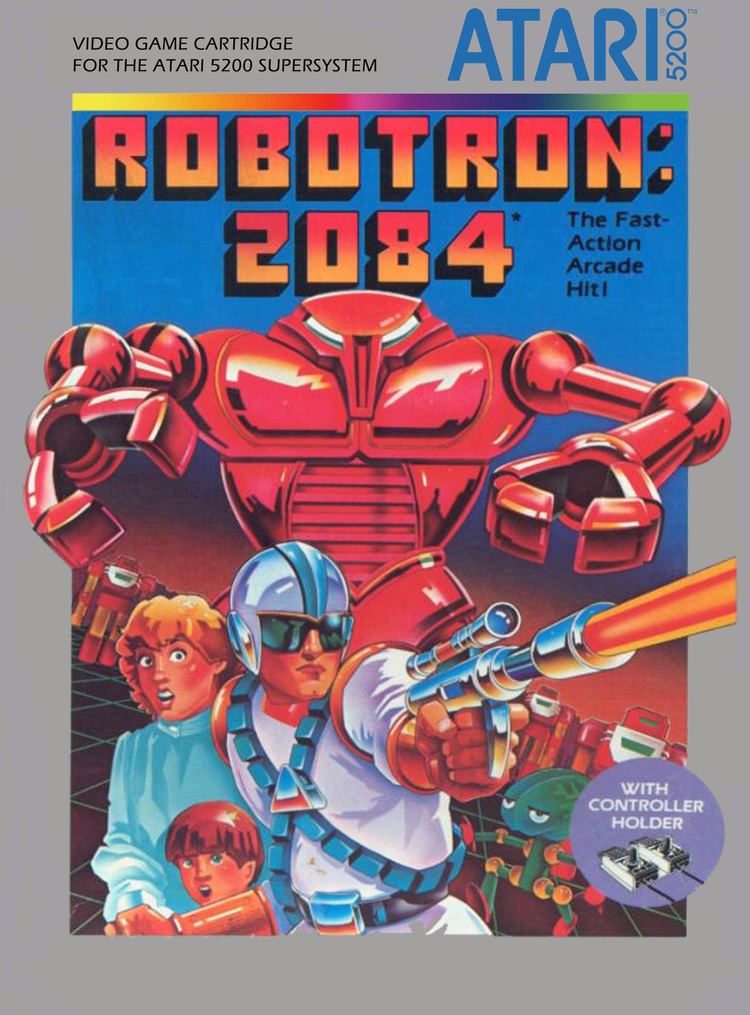
Robotron 2084 arcade 1982 feat james rolfe video game years history
Gameplay
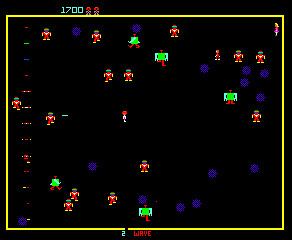
Robotron is a 2D multi-directional shooter game in which the player controls the on-screen protagonist from a top-down perspective. The game is set in the year 2084 in a fictional world where robots ("Robotrons") have taken control of the world and eradicated most of the human race. The main protagonist is a nameless superhuman attempting to save the last human family.
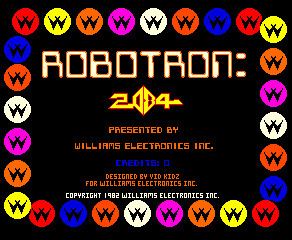
The game uses a two-joystick control scheme; the left joystick controls the on-screen character's movement, while the right controls the direction the character's weapon fires. Both joysticks allow for an input direction in one of eight ways. Each level, referred to as a "wave", is a single screen populated with a large number of various enemy robots and obstacles; types include invincible giants to robots that continually manufacture other robots that shoot the protagonist. Coming into contact with an enemy, projectile, or obstacle costs the player one life, but extra lives can be earned at certain point totals. Waves also include human family members who can be rescued to score additional points, but certain robots can either kill them or turn them into enemies. Destroying all vulnerable robots allows the player to progress to the next wave; the cycle continues until all reserve lives are lost.
Development
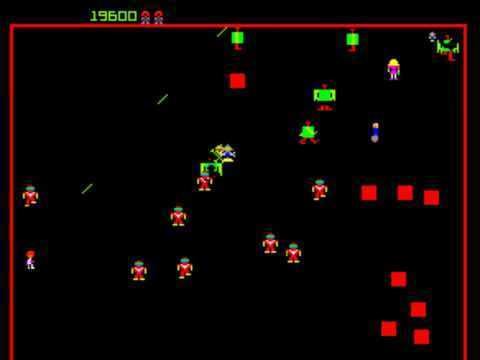
Robotron: 2084 features monaural sound and raster graphics on a 19-inch CRT monitor. It uses a Motorola 6809 central processing unit that operates at 1MHz. To produce multiple sounds on a single audio channel, the game uses a priority scheme to generate sounds in order of importance. A custom graphics coprocessor—which operates as a blitter chip—generates the on-screen objects and visual effects. The coprocessor increases the transfer speed of memory, which allows the game to simultaneously animate a large number of objects.
The game was developed in six months by Eugene Jarvis and Larry DeMar, founders of Vid Kidz. Vid Kidz served as a consulting firm that designed games for Williams Electronics (part of WMS Industries), whom Jarvis and DeMar had previously worked for. The game was designed to provide excitement for players; Jarvis described the game as an "athletic experience" derived from a "physical element" in the two joystick design. Robotron: 2084's gameplay is based on presenting the player with conflicting goals: avoid enemy attacks to survive, defeat enemies to progress, and save the family to earn points. It was first inspired by Stern Electronics' 1980 arcade game Berzerk and the Commodore PET computer game Chase. Berzerk is a shooting game in which a character traverses a maze to shoot robots, and Chase is a text-based game in which players move text characters into others. The initial concept involved a passive main character; the object was to get robots that chased the protagonist to collide with stationary, lethal obstacles. The game was deemed too boring compared to other action titles on the market and shooting was added to provide more excitement.
The dual joystick design was developed by Eugene Jarvis, and resulted from two experiences in Jarvis's life: an automobile accident and playing Berzerk. Prior to beginning development, Jarvis injured his right hand in an accident—his hand was still in a cast when he returned to work, which prevented him from using a traditional joystick with a button. While in rehabilitation, he thought of Berzerk. Though Jarvis enjoyed the game and similar titles, he was dissatisfied with the control scheme; Berzerk used a single joystick to move the on-screen character and a button to fire the weapon, which would shoot the same direction the character was facing. Jarvis noticed that if the button was held down, the character would remain stationary and the joystick could be used to fire in any direction. This method of play inspired Jarvis to add a second joystick dedicated to aiming the direction projectiles were shot. Jarvis and DeMar created a prototype using a Stargate arcade system board and two Atari 2600 controllers attached to a control panel. In retrospect, Jarvis considers the design a contradiction that blends "incredible freedom of movement" with ease of use.
The developers felt a rescue theme similar to Defender—one of their previous games—was needed to complete the game, and added a human family as a method to motivate players to earn a high score. The rescue aspect also created a situation where players had to constantly reevaluate their situation to choose the optimal action: run from enemies, shoot enemies, or rescue humans. Inspired by George Orwell's Nineteen Eighty-Four, Jarvis and DeMar worked the concept of an Orwellian world developed into the plot. The two noticed, however, that 1984 was approaching, but the state of the real world did not match that of the book. They decided to set the game further in the future, the year 2084, to provide a more realistic timeframe for their version of "Big Brother". Jarvis, a science fiction fan, based the Robotrons on the idea that computers would eventually become advanced entities that helped humans in everyday life. He believed the robots would eventually realize that humans are the cause of the world's problems and revolt against them.
Jarvis and DeMar playtested the game themselves, and continually tweaked the designs as the project progressed. Though games at the time began to use scrolling to have larger levels, the developers chose a single screen to confine the action. To instill panic in the player, the character was initially placed in the center of the game's action, and had to deal with projectiles coming from multiple directions, as opposed previous shooting games such as Space Invaders and Galaxian, where the enemies attacked from a single direction. This made for more challenging gameplay, an aspect Jarvis took pride in. Enemies were assigned to stages in different groups to create themes. Early stages were designed to be relatively simple compared to later ones. The level of difficulty was designed to increase quickly so players would struggle to complete later stages. In retrospect, Jarvis attributes his and DeMar's average player skills to the game's balanced design. Though they made the game as difficult as they could, the high end of their skills ended up being a good challenge for expert players. The graphics were given a simple appearance to avoid a cluttered game screen, and object designs were made distinct from each other to avoid confusion. Black was chosen as the background color to help characters stand out and reduce clutter.
Of special note is that Robotron had a major defect where the game would reset (Carpet pattern reset/watchdog reset) if a specific scenario was experienced while shooting an Enforcer in a corner of the screen. In 1987, Christian Gingras evaluated the code to find the problem. A visit to Williams headquarters to consult with the VidKidz resulted in code fixes that eventually made it into all later ports of the game.
Enemy designs
Each enemy was designed to exhibit a unique behavior toward the character; random elements were programmed into the enemies' behaviors to make the game more interesting. The first two designed were the simplest: Electrodes and Grunts. Electrodes are stationary objects that are lethal to the in-game characters, and Grunts are simple robots that chase the protagonist by plotting the shortest path to him. Grunts were designed to overwhelm the player with large groups. While testing the game with the new control system and the two enemies, Jarvis and DeMar were impressed by the gameplay's excitement and fun. As a result, they began steadily increasing the number of on-screen enemies to over a hundred to see if more enemies would generate more enjoyment.
Other enemies were created to add more variety. Large, indestructible Hulks, inspired by an enemy in Berzerk, were added to kill the humans on the stage. Though they cannot be destroyed, the developers decided to have the protagonist's projectiles slow the Hulk's movement as a way to help the player. Levitating Enforcers were added as enemies that could shoot back at the main character; Jarvis and DeMar liked the idea of a floating robot and felt it would be easier to animate. A projectile algorithm was devised for Enforcers to simulate enemy artificial intelligence. The developers felt a simple algorithm of shooting directly at the protagonist would be ineffective because the character's constant motion would always result in a miss. Random elements were added to make the projectile more unpredictable; the Enforcer aims at a random location in a ten pixel radius around the character, and random acceleration curves the trajectory. To further differentiate Enforcers, Jarvis devised the Spheroid enemy as a robot that continually generated Enforcers, rather than have them already on the screen like other enemies. Brains were conceived as robots that could capture humans and brainwash them into enemies called Progs. DeMar devised the final enemies as a way to further increase the game's difficulty; Tanks that fire projectiles which bounce around the screen, and Quarks as a tank-producing robot.
In the summer of 2012, Eugene Jarvis wrote a comprehensive evaluation of the Robotron Enemy Dynamics: The game is hard-coded with 40 waves, whereupon the game repeats wave 21 to 40 over and over until the game restarts back to the original wave 1, once the player completes wave 255. In the summer of 2012, Larry DeMar also provided details about how to trigger the secret room in Robotron.
Reception
Robotron: 2084 was commercially successful; Williams sold approximately 19,000 arcade cabinets, and mini cabinets and cocktail versions were later produced. The different arcade versions have since become varying levels of rarity; the cocktail and cabaret versions are very rare, while the upright cabinets are more available. It is one of the most collected arcade games, and is consistently higher priced than other titles among collectors.
The game has been positively received by critics. Author David Ellis called Robotron: 2084 a "classic favorite" of its time, and stated that, despite the game's difficulty, it is among the most popular video games in the industry. Retro Gamer rated the game number two on their list of "Top 25 Arcade Games", citing its simple and addictive design. In 2008, Guinness World Records listed it as the number eleven arcade game in technical, creative and cultural impact. Brett Alan Weiss of Allgame called it one of the industry's "most exciting and intense" games. He complimented the gameplay, graphics and audio, calling them addictive, colorful and energized respectively. The game has garnered praise from industry professionals as well. Midway Games's Tony Dormanesh and Electronic Arts' Stephen Riesenberger called Robotron: 2084 their favorite arcade game. David Thiel, a former Gottlieb audio engineer, referred to the game as the "pinnacle of interactive game design". Xot's John Leffingwell described Robotron: 2084 as "the perfect blend of mayhem and simplicity", and commented that its plot was an interesting commentary. Jeff Peters from GearWorks Games praised the playing field as "crisp and clear", and described the strategy and dexterity required to play as a challenge to the senses. He summarized the game as "one of the best examples of game play design and execution."
Critics lauded Robotron: 2084's gameplay. Authors Rusel DeMaria and Johnny Wilson enjoyed the excitement created by the constant waves of robots and fear of the character dying. They considered it one of the more impressive games produced from the 80s and 90s. Author John Vince considered the reward system (saving humans) and strategic elements as positive components. ACE magazine's David Upchurch commented that despite the poor graphics and basic design, the gameplay's simplicity was a strong point. The control scheme in particular was well received. DeMaria and Wilson considered it a highlight which provided the player a tactical advantage. Owen Linzmayer of Creative Computing Video & Arcade Games praised the freedom of movement afforded by the controls. Ellis commented that the unique control scheme was a factor in the game's success. Retro Gamer lauded the controls, describing them as "one of the greatest control systems of all time." In retrospect, DeMar felt players continued to play the game because the control scheme offered a high level of precision.
Legacy
Jarvis's contributions to the game's development are often cited among his accolades. Vince considered him as one of the originators of "high-action" and "reflex-based" arcade games, citing Robotron: 2084's gameplay among other games designed by Jarvis. In 2007, IGN listed Eugene Jarvis as a top game designer whose titles (Defender, Robotron 2084, and Smash TV) have influenced the video game industry. GamesTM referred to the game as the pinnacle of his career. Shane R. Monroe of RetroGaming Radio called Robotron "...the greatest twitch and greed game of all time."
Bill Loguidice and Matt Barton of Gamasutra commented that Robotron's success, along with Defender, illustrated that video game enthusiasts were ready for more difficult games with complex controls. Though not the first to implement it, Robotron: 2084's use of dual joysticks popularized the design among 2D shooting games, and has since been copied by other arcade-style games. The control scheme has appeared in several other titles produced by Midway Games: Inferno, Smash TV, and Total Carnage. Many shooting games on Xbox Live Arcade and PlayStation Network use this dual control design. The 2003 title Geometry Wars and its sequels also use a similar control scheme. The input design was most prominent in arcade games until video games with three-dimensional (3D) graphics became popular in the late 1990s. Jarvis attributes the lack of proliferation in the home market to the absence of hardware that offered two side-by-side joysticks. Most 3D games, however, use the dual joystick scheme to control the movement of a character and a camera. Few console games, like the 2004 title Jet Li: Rise to Honor, use two joysticks for movement and attacking.
Remakes and sequels
Jarvis planned to produce sequels, but the North American video game crash of 1983 halted most video game production for a few years. Prior to the full effects of the crash, Vid Kidz developed an official sequel, Blaster in 1983. The game is set in the same universe and takes place in 2085 in a world overrun by Robotrons. Williams considered creating a proper sequel in the mid-1980s as well as a movie adaptation. The company released a sequel with 3D graphics titled Robotron X in 1996 for the Sony PlayStation and personal computers. It was ported two years later to the Nintendo 64 as Robotron 64. In addition to the graphical update, the game includes new audio and multiple camera angles. Though the game features similar gameplay as the original, it was not as well received. Authors Andrew Rollings and Ernest Adams considered the moving camera in the 3D environment a negative update. They felt the original format—an overhead perspective of a single screen—presented the player with all the necessary information and relied on the player's skill. The moving camera angle, however, obscured areas of the playing field and could result in the player being shot by an enemy that suddenly appeared. Vince echoed similar statements, stating that the gameplay suffered from the loss of important aspects from the original. Rollings and Adams, however, attribute the fad of classic video game remakes in the late 1990s in part to Robotron X's release.
Robotron: 2084 has been remade on different platforms. Beginning in 1983, the game was ported to several platforms including the Atari 5200, Atari 7800, Apple IIe, Commodore 64, and TI-99/4A. Most early conversions did not have a dual joystick and were received less favorably by critics. However, later releases did support dual joystick play with standard dual analog stick controllers, including the 2003 Playstation 2 and Xbox compilation titled Midway Arcade Treasures.
In 2000, a web-based version of Robotron: 2084, along with nine other classic arcade games, were published on Shockwave.com (a website related to Adobe Shockwave). Four years later, Midway Games also launched a website featuring the Shockwave versions.
Robotron 2084 has been included in several multi-platform compilations: the 1996 Williams Arcade's Greatest Hits, the 2000 Midway's Greatest Arcade Hits, the 2003 Midway Arcade Treasures, and the 2012 Midway Arcade Origins. It also appeared in an expansion to Lego Dimensions.
In 2004, Midway Games planned to release a plug and play version of Robotron: 2084 as part of a line of TV Games, however, it was never released. Robotron: 2084 became available for download via Microsoft's Xbox Live Arcade in November 2005. In February 2010, however, Microsoft removed it from the service citing permission issues. The Xbox Live version included high-definition graphics and two-player cooperative multi-player with one player controlling the movement and another the shooting. Scores were tracked via an online ranking system.
The game has also inspired other titles. The 1990 arcade game Smash TV, also designed by Jarvis, features a similar design—two joysticks used to shoot numerous enemies on a single screen—as well as ideas he intended to include in sequels. In 1991, Jeff Minter released a shareware game titled Llamatron based on Robotron: 2084's design. Twenty years later, Minter released an upgraded version titled Minotron: 2112 on the iPhone.
Reverse engineering work
Annotated reverse engineering of the Robotron: 2084 arcade game can be found at http://www.seanriddle.com
Robotron II
The video game crash of the early 80's saw the VidKidz disband before creating Robotron's sequel. DeMar went back to pinball development and Jarvis went back to college. Later, both went on to entertainment industry successes with hits in pinball, racing games, light gun games, casino games, and social media games. Robotron II remained a forgotten project, never to be implemented.
In other media
The robots attacking the player show up in the movie "Pixels", near the end where the arcade characters begin a full-on attack on Earth. The game is also mentioned in the novel Ready Player One as protagonist Wade Watts' favorite video game. A modified version of the game appears in Fallout 4's DLC Automatron as a hidden mini game called Automatron, reskinned with the robots of the franchise.
- Rapper M.F Doom says "this goes out to man, woman and child from Robotron" in the song "Put Your Quarters Up".
